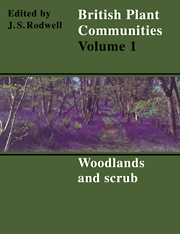Book contents
- Frontmatter
- Contents
- List of Figures
- Foreword
- Preface and Acknowledgements
- Preamble
- General Introduction
- Woodlands and Scrub
- Introduction to Woodlands and Scrub
- Key To Woodlands and Scrub
- Community Descriptions
- W1 Salix Cinerea-Galium Palustre woodland
- W2 Salix Cinerea-Betula Pubescens-Phragmites Australis Woodland
- W3 Salix Pentandra-Carex Rostrata Woodland
- W4 Betula Pubescens-Molinia Caerulea Woodland
- W5 Alnus Glutinosa-Carex Paniculata Woodland
- W6 Alnus Glutinosa-Urtica Jzozca Woodland
- W7 Ainus Glutinosa-Fraxinus Excelsior-Lysimachia Nemorum Woodland
- W8 Fraxinus Excelsior-Acer Campestre-Mercurialis Perennis Woodland
- W9 Fraxinus Excelsior-Sorbus Aucuparia-Mercurialis Perennis Woodland
- W10 Quereus Robur-Pteridium Aquilinum-Rubus Fruticosus Woodland
- W11 Quereus Petraea-Betula Pubescens-Oxalis Acetosella Woodland
- W12 Fagus Sylvatica-Mercurialis Perennis Woodland
- W13 Taxus Baccata Woodland
- W14 Fagus Sylvatica-Rubus Fruticosus Woodland
- W15 Fagus Sylvatica-Deschampsia Flexuosa Woodland
- W16 Quereus spp.-Betula spp.-Deschampsia Flexuosa Woodland
- W17 Quereus Petraea-Betula Pubescens-Dicranum Majus Woodland
- W18 Pinus Sylvestris-Hylocomium Splendens Woodland
- W19 Juniperus Communis Ssp. Communis-Oxalis Acetosella Woodland
- W20 Salix Lapponum-Luzula Sylvatica Scrub
- W21 Crataegus monogyna-Hedera helix scrub
- W22 Prunus Spinosa-Rubus Fruticosus Scrub
- W23 Ulex Europaeus-Rubus Fruticosus Scrub
- W24 Rubus Fruticosus-Holcus Lanatus Underscrub
- W25 Pteridium Aquilinum-Rubus Fruticosus Underscrub
- Index of Synonyms to Woodlands and Scrub
- Index of Species in Woodlands and Scrub
- Bibliography
W25 - Pteridium Aquilinum-Rubus Fruticosus Underscrub
Published online by Cambridge University Press: 04 July 2020
- Frontmatter
- Contents
- List of Figures
- Foreword
- Preface and Acknowledgements
- Preamble
- General Introduction
- Woodlands and Scrub
- Introduction to Woodlands and Scrub
- Key To Woodlands and Scrub
- Community Descriptions
- W1 Salix Cinerea-Galium Palustre woodland
- W2 Salix Cinerea-Betula Pubescens-Phragmites Australis Woodland
- W3 Salix Pentandra-Carex Rostrata Woodland
- W4 Betula Pubescens-Molinia Caerulea Woodland
- W5 Alnus Glutinosa-Carex Paniculata Woodland
- W6 Alnus Glutinosa-Urtica Jzozca Woodland
- W7 Ainus Glutinosa-Fraxinus Excelsior-Lysimachia Nemorum Woodland
- W8 Fraxinus Excelsior-Acer Campestre-Mercurialis Perennis Woodland
- W9 Fraxinus Excelsior-Sorbus Aucuparia-Mercurialis Perennis Woodland
- W10 Quereus Robur-Pteridium Aquilinum-Rubus Fruticosus Woodland
- W11 Quereus Petraea-Betula Pubescens-Oxalis Acetosella Woodland
- W12 Fagus Sylvatica-Mercurialis Perennis Woodland
- W13 Taxus Baccata Woodland
- W14 Fagus Sylvatica-Rubus Fruticosus Woodland
- W15 Fagus Sylvatica-Deschampsia Flexuosa Woodland
- W16 Quereus spp.-Betula spp.-Deschampsia Flexuosa Woodland
- W17 Quereus Petraea-Betula Pubescens-Dicranum Majus Woodland
- W18 Pinus Sylvestris-Hylocomium Splendens Woodland
- W19 Juniperus Communis Ssp. Communis-Oxalis Acetosella Woodland
- W20 Salix Lapponum-Luzula Sylvatica Scrub
- W21 Crataegus monogyna-Hedera helix scrub
- W22 Prunus Spinosa-Rubus Fruticosus Scrub
- W23 Ulex Europaeus-Rubus Fruticosus Scrub
- W24 Rubus Fruticosus-Holcus Lanatus Underscrub
- W25 Pteridium Aquilinum-Rubus Fruticosus Underscrub
- Index of Synonyms to Woodlands and Scrub
- Index of Species in Woodlands and Scrub
- Bibliography
Summary
Synonymy
Marginal Society Salisbury 1981a p.p.; Pteridietum auct. angl. p.p.
Constant species
Pteridium aquilinum, Rubus fruticosus agg.
Physiognomy
The Pteridium aquilinum-Rubus fruticosus agg. underscrub brings together vegetation dominated by mixtures of bracken and bramble. As with the Rubus-Holcus underscrub, although this community is often found closely associated with taller woody vegetation, shrubs and trees generally make a negligible contribution to the cover: scattered Crataegus monogyna, Sambucus nigra and Prunus spinosa are sometimes found and there can be very occasional saplings of Fraxinus excelsior, Acer pseudoplatanus, Quercus robur or Fagus sylvatica.
Pteridium is generally the more abundant of the two constants and, by mid-summer when its fronds are fully unfurled, it can form a virtually complete canopy to the vegetation up to a metre or more in height. In other stands, brambles are more prominent, forming a thick tangle of arching shoots with patches of bracken between or scattered fronds throughout. The brambles, which generally retain some of their leaves through the winter, may become more conspicuous when the bracken has died back, though their shoots often hold the dead fronds upright until they decay. Other undershrubs are infrequent, though Rubus idaeus, Rosa canina agg. and Rosa arvensis have been recorded in one subcommunity and Ulex europaeus is a scarce associate in the other.
No other plants attain constancy throughout and many show a marked preference for one or other of the sub-communities. Also, with the often dense cover of the dominants, the abundance of these associates is sometimes low and some are very much confined to more open areas between the bracken and bramble. Of those species which can be found throughout, Urtica dioica and Holcus lanatus are the most common, with Silene dioica, Rumex acetosa and Viola riviniana occasional. Hedera helix sometimes forms a patchy ground carpet and there can be some scrambling Lonicera periclyme-num. Weedy plants like Epilobium angustifolium and Cirsium arvense can be locally prominent and, in more open places, Festuca rubra, Arrhenatherum elatius and Heracleum sphondylium are sometimes found, though these are never so frequent here as in the Rubus-Holcus underscrub.
Bryophytes are strongly preferential to one of the subcommunities but, even there, are not very numerous or consistently abundant.
- Type
- Chapter
- Information
- British Plant Communities , pp. 364 - 368Publisher: Cambridge University PressPrint publication year: 1991

